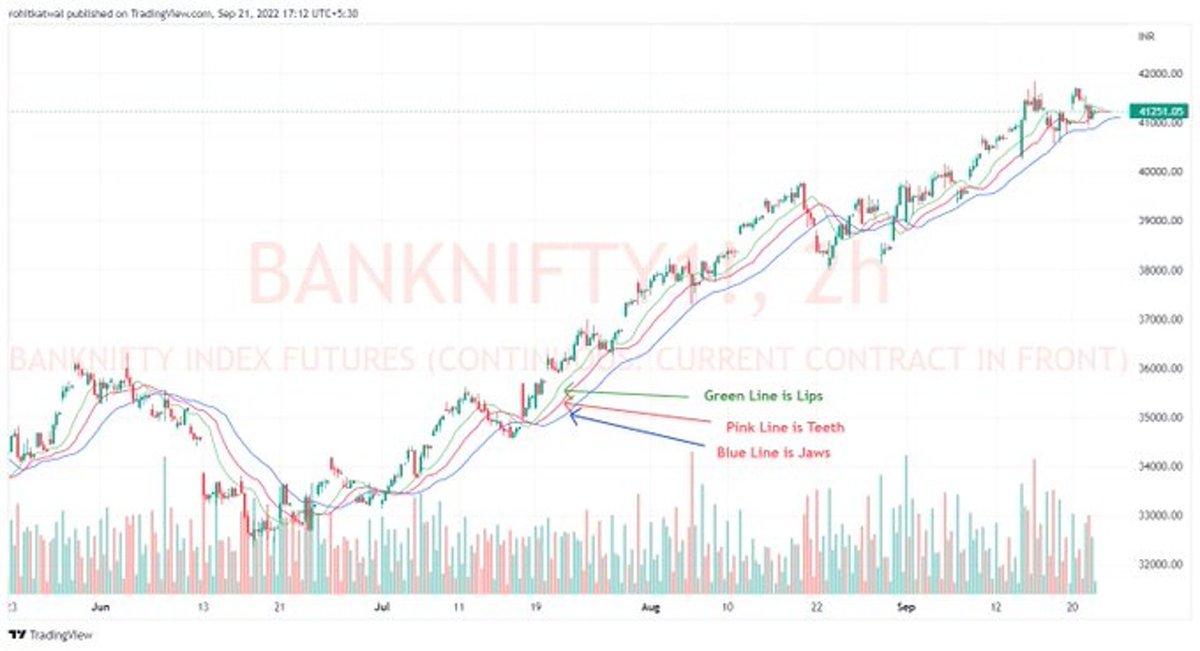Here are key takeaways from the book 👇👇
Knowledge sharing initiative Book 4: "The interpretation of financial statements" by Benjamin Graham.
This book was published around 1937 by investing legend Ben Graham. Ben is also regarded as the guy under whom the great Warren Buffett started his investing journey.

Here are key takeaways from the book 👇👇
2.Assets=Tangible (PP&E, inventories, accounts receivable, cash)+intangible Assets (trademark, lease rights, goodwill)
4.Tangible assets are written down through depreciation & intangibles are written down through amortization or impairment
6. Depletion gets applied in commodity businesses like cement, mining, and crude oil.
As they inflated their asset value leading to inflated book value, which was later written off as one-time charges against earnings/profit
8.True value of a company’s assets may be different from the B/s total
10. It is not so essential to invest only in cos. with dominant size, as countless e.g of smaller cos. prospering more than larger ones can be seen in the mkts
High ratio indicates-co. will easily meet short-term obligations
14.Working capital(WC)=current assets–current liabilities
WC makes it easier for a co. to run daily operations & meet emergency needs without taking new financing
15. Quick Ratio = (Current Assets – Inventory)/Current Liabilities
Inventory turnover can be compared on a year-to-year basis. Measures how efficiently the company turns inventories into profits.
18.Valuing companies on book value is majorly applied in banks, insurance cos, & holding companies
23. Net Current Asset Value (NCAV)=Current assets–liabilities & preferred stock.
25. Earning Power of a company = Expected earnings in the future
26. We take current & past earnings as a guide to predict future earnings.
28.Investing requires a balance between facts of the past and possibilities of the future
a) How certain am I that this favorable trend will continue,&
b) How large a price am I paying in advance for the expected continuance of the trend?”
Credits @FinnacleAcademy
Here is the book link: https://t.co/fjfj11MKLf
More from Investment Books
Learn Investing Lessons From a Top Fund Manager in India
24 Videos selected from 24000+ Video repositories (BQ Prime @_nirajshah)
1) Vijay Kedia (@VijayKedia1)
2) Kenneth Andrade
1.0 https://t.co/0JjC7bw5TW (2018)
2.0 https://t.co/2YNkFMyuJL (2017)
3.0 https://t.co/aY8ZnYSoIO (2020)
3) Basant Maheshwari (@BMTheEquityDesk)
4) Samit Vartak (Sage Investment Manager @SamitVartak )
1.0 https://t.co/CgIYR8dLuk (2017)
2.0 https://t.co/LU9KUcV5dI (2021)
3.0 https://t.co/zHrOMEE646 (2022)
24 Videos selected from 24000+ Video repositories (BQ Prime @_nirajshah)
1) Vijay Kedia (@VijayKedia1)
2) Kenneth Andrade
1.0 https://t.co/0JjC7bw5TW (2018)
2.0 https://t.co/2YNkFMyuJL (2017)
3.0 https://t.co/aY8ZnYSoIO (2020)
3) Basant Maheshwari (@BMTheEquityDesk)
4) Samit Vartak (Sage Investment Manager @SamitVartak )
1.0 https://t.co/CgIYR8dLuk (2017)
2.0 https://t.co/LU9KUcV5dI (2021)
3.0 https://t.co/zHrOMEE646 (2022)
Thread Best books recommendation by one of best investor I knew @insharebazaar (Virtually)
He grab many multibagger stocks and His style also unique(1st Seen interview in @TraderHarneet's YT Channel)
He follow Simple process
Young Intelligent Investor who also appeared in ET
1. One Up On Wall Street
2. Rich Dad Poor Dad
Access here : https://t.co/UWOCF732z6
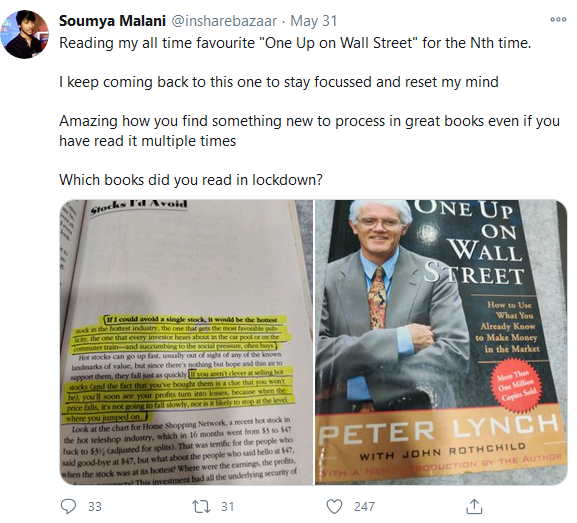
3. The Unusual Billionaires
4. Trading in the Zone
https://t.co/G7mqVPtEM0
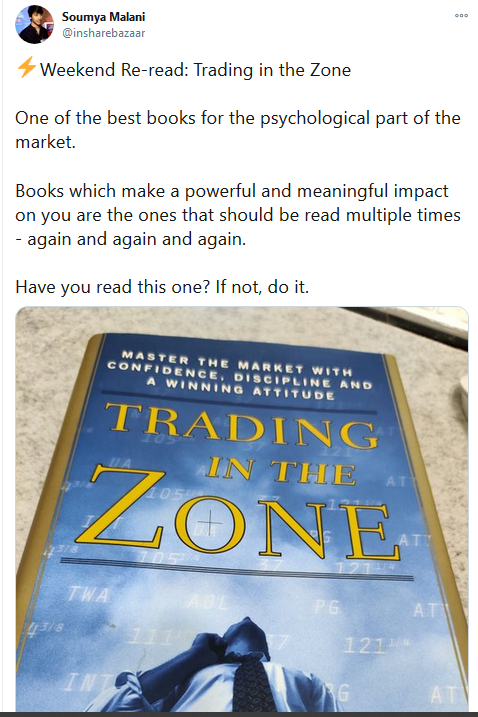
5. Market Wizards
6. The Intelligent Investor
https://t.co/yPKBzYyPAl

7. The Five Rules for Successful Stock Investing
8. Reminiscences of a Stock Operator
https://t.co/PiioB3hdHP

He grab many multibagger stocks and His style also unique(1st Seen interview in @TraderHarneet's YT Channel)
He follow Simple process
Young Intelligent Investor who also appeared in ET
1. One Up On Wall Street
2. Rich Dad Poor Dad
Access here : https://t.co/UWOCF732z6

3. The Unusual Billionaires
4. Trading in the Zone
https://t.co/G7mqVPtEM0

5. Market Wizards
6. The Intelligent Investor
https://t.co/yPKBzYyPAl

7. The Five Rules for Successful Stock Investing
8. Reminiscences of a Stock Operator
https://t.co/PiioB3hdHP

More from Trading
Tether Price Manipulation Thread:
Tether has been manipulating #Bitcoin's price upwards for years now by printing unlimited, and unbacked $USDT.
This thread will cover the controversial aspects surrounding Tether, and how it will eventually meet its demise.

1) Tether is a stable coin that was first launched in 2012.
According to the company, Tether is backed 1:1 with the U.S dollar, although this isn't actually the case.
Bitfinex, and Tether have refused to show audits of their reserves, which is held in offshore bank accounts.

2) In 2019, The United States District Court sued Bitfinex, Tether, and Poloniex for being involved in a massive price manipulation, and fraud scheme in the crypto markets.
In a court hearing, Tether's lawyer admitted the stable coin was only backed by 74% cash, and securities.

3) On Jan 15th 2021, iFinex is supposed to submit documents requested by NYAG's investigation.
These documents will be consequential to the case.
https://t.co/82UuLLLXWK

4) How the scam works:
Tether can print infinite amounts of (worthless) $USDT.
They then inject this into BTC, ETH, LTC, (and others) to cause prices to pump.
Notice how during the months they stopped printing Tether, the market moves sideways or drops significantly.

Tether has been manipulating #Bitcoin's price upwards for years now by printing unlimited, and unbacked $USDT.
This thread will cover the controversial aspects surrounding Tether, and how it will eventually meet its demise.

1) Tether is a stable coin that was first launched in 2012.
According to the company, Tether is backed 1:1 with the U.S dollar, although this isn't actually the case.
Bitfinex, and Tether have refused to show audits of their reserves, which is held in offshore bank accounts.

2) In 2019, The United States District Court sued Bitfinex, Tether, and Poloniex for being involved in a massive price manipulation, and fraud scheme in the crypto markets.
In a court hearing, Tether's lawyer admitted the stable coin was only backed by 74% cash, and securities.

3) On Jan 15th 2021, iFinex is supposed to submit documents requested by NYAG's investigation.
These documents will be consequential to the case.
https://t.co/82UuLLLXWK

4) How the scam works:
Tether can print infinite amounts of (worthless) $USDT.
They then inject this into BTC, ETH, LTC, (and others) to cause prices to pump.
Notice how during the months they stopped printing Tether, the market moves sideways or drops significantly.

You May Also Like
BREAKING: @CommonsCMS @DamianCollins just released previously sealed #Six4Three @Facebook documents:
Some random interesting tidbits:
1) Zuck approves shutting down platform API access for Twitter's when Vine is released #competition
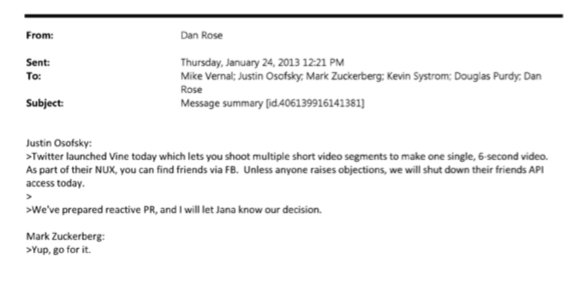
2) Facebook engineered ways to access user's call history w/o alerting users:
Team considered access to call history considered 'high PR risk' but 'growth team will charge ahead'. @Facebook created upgrade path to access data w/o subjecting users to Android permissions dialogue.
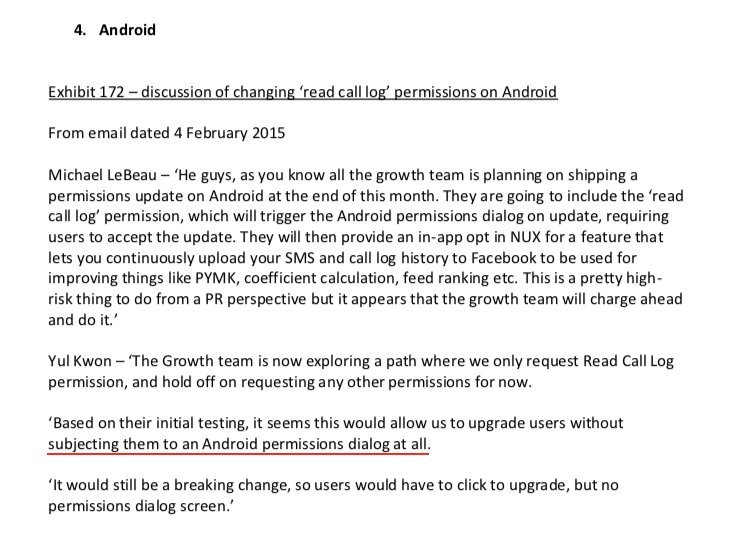
3) The above also confirms @kashhill and other's suspicion that call history was used to improve PYMK (People You May Know) suggestions and newsfeed rankings.
4) Docs also shed more light into @dseetharaman's story on @Facebook monitoring users' @Onavo VPN activity to determine what competitors to mimic or acquire in 2013.
https://t.co/PwiRIL3v9x
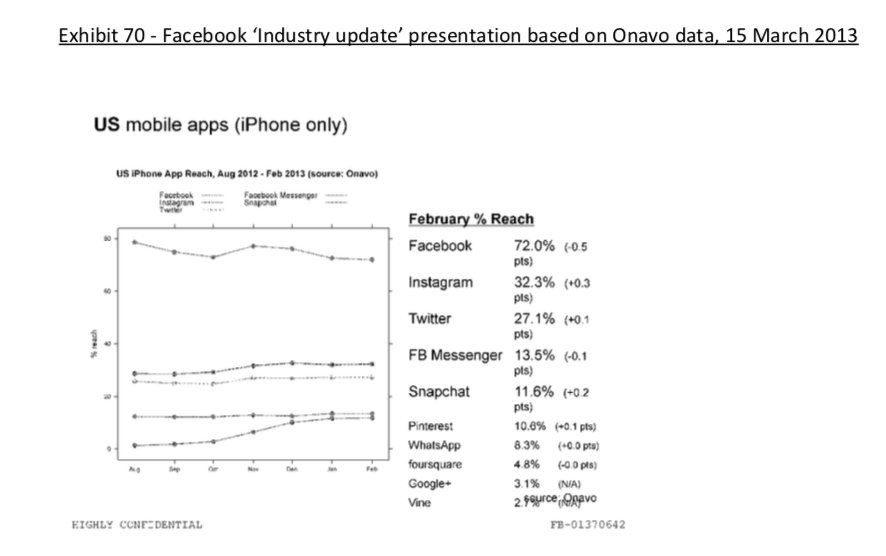
Some random interesting tidbits:
1) Zuck approves shutting down platform API access for Twitter's when Vine is released #competition

2) Facebook engineered ways to access user's call history w/o alerting users:
Team considered access to call history considered 'high PR risk' but 'growth team will charge ahead'. @Facebook created upgrade path to access data w/o subjecting users to Android permissions dialogue.

3) The above also confirms @kashhill and other's suspicion that call history was used to improve PYMK (People You May Know) suggestions and newsfeed rankings.
4) Docs also shed more light into @dseetharaman's story on @Facebook monitoring users' @Onavo VPN activity to determine what competitors to mimic or acquire in 2013.
https://t.co/PwiRIL3v9x









